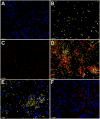Coaggregation occurs amongst bacteria within and between biofilms in domestic showerheads
- PMID: 23194413
- PMCID: PMC4199578
- DOI: 10.1080/08927014.2012.744395
Coaggregation occurs amongst bacteria within and between biofilms in domestic showerheads
Abstract
Showerheads support the development of multi-species biofilms that can be unsightly, produce malodor, and may harbor pathogens. The outer-surface spray-plates of many showerheads support visible biofilms that likely contain a mixture of bacteria from freshwater and potentially from human users. Coaggregation, a mechanism by which genetically distinct bacteria specifically recognize one another, may contribute to the retention and enrichment of different species within these biofilms. The aim of this work was to describe the bacterial composition of outer spray-plate biofilms of three domestic showerheads and to determine the intra- and inter-biofilm coaggregation ability of each culturable isolate. The bacterial composition of the three biofilms was determined by using bacterial tag-encoded FLX amplicon pyrosequencing (bTEFAP) and by culturing on R2A medium. An average of 31 genera per biofilm were identified using bTEFAP and a total of 30 isolates were cultured. Even though the microbial diversity of each showerhead biofilm differed, every cultured isolate was able to coaggregate with at least one other isolate from the same or different showerhead biofilm. Promiscuous coaggregating isolates belonged to the genera Brevundimonas, Micrococcus, and Lysobacter. This work suggests that coaggregation may be a common feature of showerhead biofilms. Characterization of the mechanisms mediating coaggregation, and the inter-species interactions they facilitate, may allow for novel strategies to inhibit biofilm development.
Figures




References
-
- Acosta-Martinez V, Dowd SE, Bell CW, Lasconao R, Booker JD, Zobeck TM, DRU Microbial Community Composition as Affected by Dryland Cropping Systems and Tillage in a Semiarid Sandy Soil. Diversity. 2010;2:910–931.
-
- Bauer M, Mathieu L, Deloge-Abarkan M, Remen T, Tossa P, Hartemann P, Zmirou-Navier D. Legionella bacteria in shower aerosols increase the risk of Pontiac fever among older people in retirement homes. J Epidemiol Community Health. 2008;62:913–920. - PubMed
-
- Bloetscher F, Meeroff DE, Pisani JV, Long SC. Resolving problematic biofilms in buildings and compounds. Environmental Engineering Science. 2010;27:767–776.
Publication types
MeSH terms
Substances
Grants and funding
LinkOut - more resources
Full Text Sources
Other Literature Sources
